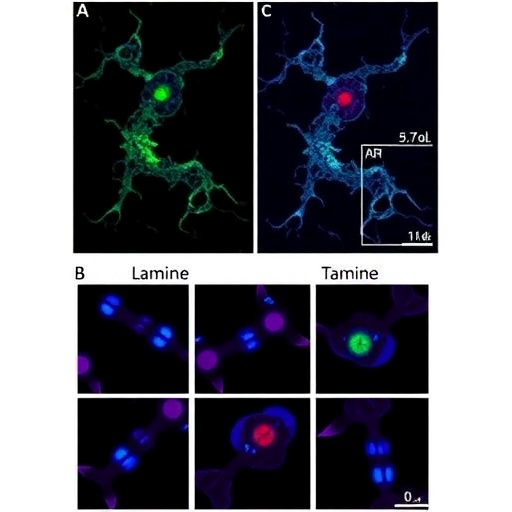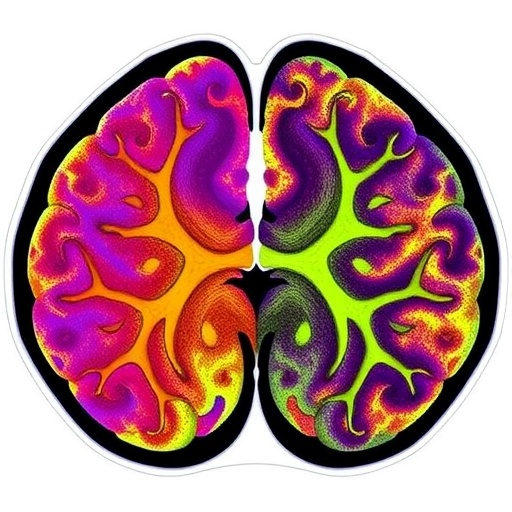A groundbreaking study published in Nature Communications unveils a novel cellular mechanism underpinning LAMA2-related muscular dystrophy, offering fresh insights into muscle stem cell dysfunction. This research, carried out by McGowan, Reinhard, Lewerenz, and their colleagues, reveals that the loss of cell-autonomously secreted laminin-α2 critically impairs the regenerative capacity of muscle stem cells, advancing our understanding of this debilitating genetic disorder.
LAMA2-related muscular dystrophy (LAMA2-MD) is a severe form of congenital muscular dystrophy caused by mutations in the LAMA2 gene, which encodes the laminin-α2 chain, a crucial component of the extracellular matrix (ECM) in muscle tissue. The disease is characterized by muscle weakness, atrophy, and impaired regeneration, traditionally attributed to the disruption of the laminin network in the muscle basement membrane. However, the precise mechanisms at the cellular level, particularly relating to muscle stem cell behavior, have remained elusive until now.
Muscle stem cells, also known as satellite cells, reside in a specialized niche between the muscle fiber membrane and the surrounding basement membrane. These cells are pivotal for muscle repair following injury or disease, as they proliferate and differentiate to regenerate damaged muscle fibers. Laminins, especially laminin-α2, are fundamental to maintaining the structural and signaling milieu of this niche. The study by McGowan and colleagues provides compelling evidence that muscle stem cells themselves secrete laminin-α2 in a cell-autonomous manner, a process crucial for their own function.
Through an array of sophisticated molecular and imaging techniques, the researchers demonstrated that muscle stem cells with LAMA2 mutations show a significant reduction in laminin-α2 secretion, leading to compromised ECM integrity. This deficit disrupts the biophysical and biochemical signals required for proper stem cell proliferation and differentiation, effectively hamstringing muscle regeneration. Notably, the work differentiates between the laminin sourced from muscle fibers and that secreted by the stem cells, underscoring the newly discovered autocrine role of laminin-α2.
The implications of this cell-autonomous secretion extend beyond ECM structure; laminin-α2 participates in key signaling pathways that regulate stem cell fate decisions. Its loss alters interactions with integrin receptors on the stem cell surface, perturbing downstream cascades involved in cell cycle progression and lineage commitment. These findings suggest that the pathology of LAMA2-MD stems not only from structural defects in muscle tissue but also from intrinsic deficiencies within the regenerative cells themselves.
Moreover, the research unveils how the absence of secreted laminin-α2 contributes to a maladaptive microenvironment that exacerbates muscle degeneration. The altered niche milieu fails to support the dynamic remodeling required during muscle repair, fostering a vicious cycle of impaired regeneration and progressive muscle wasting. Importantly, these insights challenge the traditional dogma that muscle fiber abnormalities are the sole drivers of LAMA2-related muscular dystrophy and highlight stem cells as active players in disease progression.
In dissecting the molecular landscape, McGowan et al. utilized gene editing to selectively disrupt laminin-α2 secretion in isolated muscle stem cells, effectively reproducing disease phenotypes in vitro. Rescue experiments demonstrated that restoring laminin-α2 production in these cells reinstated their regenerative potential, providing proof-of-concept for therapeutic strategies aimed at targeting stem cell-autonomous defects.
This work also sheds light on the heterogeneity within muscle stem cell populations, revealing that only subpopulations exhibit robust laminin-α2 secretion. These discrepancies correlate with varying regenerative capacities, implicating laminin-α2 as a marker of stem cell viability and robustness. Understanding such heterogeneity may inform the development of precision medicine approaches tailored to enhance endogenous muscle repair mechanisms.
The significance of these discoveries is further amplified by their translational potential. Current treatments for LAMA2-MD are largely supportive, focusing on symptom management rather than addressing underlying cellular dysfunctions. By identifying the loss of laminin-α2 secretion as a critical node in muscle stem cell failure, this research opens avenues to design interventions that restore or mimic laminin function, potentially halting or reversing muscle degeneration.
Another facet explored in the study involves how alterations in the extracellular matrix environment impact stem cell metabolism and mechanotransduction. Given that muscle stem cells respond to mechanical cues mediated by laminin interactions, their inability to secrete laminin-α2 disrupts these signals, skewing cell metabolism towards states incompatible with regeneration. This connection between ECM integrity and stem cell metabolic programming represents a novel dimension in muscular dystrophy pathology.
Additionally, the investigation highlights the interplay between laminin-α2 and other ECM constituents, such as collagen and fibronectin, within the satellite cell niche. The loss of laminin-α2 dismantles the delicate ECM network, impairing not just structural support but also the molecular crosstalk essential for coordinating muscle regeneration. This systemic view of ECM-stem cell interdependencies offers a paradigm shift in how muscular dystrophies could be conceptualized and treated.
The authors emphasize the importance of considering both cell-autonomous and non-autonomous effects in studying muscular dystrophies, as the bidirectional communication between muscle fibers, stem cells, and their ECM milieu shapes disease trajectories. This holistic understanding underscores the need for multi-targeted therapeutic regimens that rescue stem cell function while preserving or reconstructing ECM integrity.
Future research directions proposed by the study include exploring small molecules or gene therapies capable of upregulating laminin-α2 expression specifically in muscle stem cells or delivering exogenous laminin-α2 analogs to restore niche homeostasis. Additionally, the potential of engineering synthetic ECM scaffolds mimicking laminin-α2’s functional domains offers exciting prospects for regenerative medicine applications.
In summary, McGowan and colleagues have elucidated a critical, previously underappreciated mechanism whereby loss of cell-autonomous laminin-α2 secretion in muscle stem cells compromises their regenerative function in LAMA2-related muscular dystrophy. This seminal work not only deepens our molecular understanding of muscle pathology but also lays a robust foundation for innovative therapeutic strategies aimed at restoring muscle health by targeting the stem cell niche.
As this research reverberates through the muscular dystrophy field, it is poised to reshape clinical approaches and inspire a new wave of investigations into ECM-stem cell interactions, ultimately striving toward effective cures for patients burdened by these devastating diseases.
Subject of Research: Muscle stem cell dysfunction mechanisms in LAMA2-related muscular dystrophy.
Article Title: Loss of cell-autonomously secreted laminin-α2 drives muscle stem cell dysfunction in LAMA2-related muscular dystrophy.
Article References:
McGowan, T.J., Reinhard, J.R., Lewerenz, N. et al. Loss of cell-autonomously secreted laminin-α2 drives muscle stem cell dysfunction in LAMA2-related muscular dystrophy. Nat Commun 16, 10674 (2025). https://doi.org/10.1038/s41467-025-65703-1
Image Credits: AI Generated
DOI: https://doi.org/10.1038/s41467-025-65703-1
Tags: basement membrane integritycellular mechanisms of muscle regenerationcongenital muscular dystrophy researchextracellular matrix in muscle tissuegenetic disorders in muscleLAMA2-related muscular dystrophyLaminin-α2muscle atrophy and weaknessmuscle fiber regenerationmuscle stem cell dysfunctionsatellite cells and muscle repairsignaling in muscle stem cells





